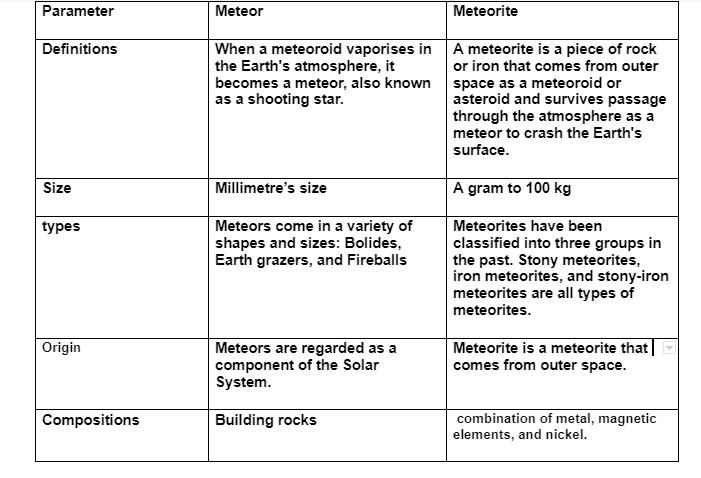Introduction
Have you ever wondered how a shooting star falls in the night sky? Is it a star or some other foreign body that we see flying down, or is it something else entirely? What is the name of this flashy object? Is it a comet, an asteroid, or a meteor? How do we tell the difference between these things? It’s vital to remember that the Earth is constantly blasted with thousands of tons of space dust and other small debris. Another word we can say It’s probably safe to say that the rocks from space provoke both awe and dread in humans. Knowing a little more about meteors and meteorites, on the other hand, may help to dispel some of your concerns.
Meteor
Meteors are fireballs or shooting stars that enter Earth’s atmosphere at great speeds and burn up as a result of the atmosphere. As a meteoroid or asteroid enters the Earth’s atmosphere and breaks apart, it emits light. The meteoroid will fly unchanged through space, but it will experience high friction and melt once it reaches the Earth’s atmosphere. A meteor tail created by a grain-sized meteoroid is around a metre broad but could be many miles long due to the tremendous speed of the debris. Meteors are classified into several categories based on their size and brightness. Earth grazers are meteors with the longest and most colourful tails that streak close to the horizon. The most common type of meteor is a fireball, which lasts longer and shines brighter than earth grazers. Bolides are larger than fireballs and most of the time they detonate in the atmosphere. As they emit a sonic boom, we can hear an explosion and feel it on the ground.
Meteors come in a variety of shapes and sizes.
Earth grazers are meteors that streak near to the horizon and have the longest and most colourful tails. A fireball is the most common type of meteor, as it is brighter and lasts longer than earth grazers. They could be the size of a basketball or the size of a small car.Bolides are larger than fireballs and explode in the atmosphere the majority of the time. Their explosion may be heard and felt on the ground as they create a sonic boom.
What are meteor showers and how do they happen?
We can only see a few meteors during a meteor shower, and the sky appears to be filled with fireworks. When a meteor shower happens, we can see that the entire shower originates from a single point called the radiant point. Meteor showers are given names based on constellations. The Leonid meteor shower, named after the constellation Leonid, is the most well-known meteor shower. The shower appears to be coming from the constellation, but the comet Tempel-Tuttle is the source.
 Profile
Profile Settings
Settings Refer your friends
Refer your friends Sign out
Sign out







